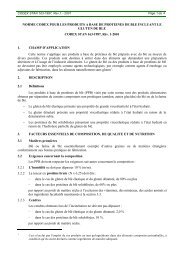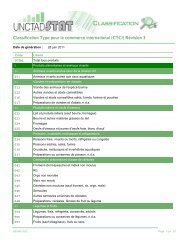issues and constraints related to the development of cashew nuts ...
issues and constraints related to the development of cashew nuts ...
issues and constraints related to the development of cashew nuts ...
You also want an ePaper? Increase the reach of your titles
YUMPU automatically turns print PDFs into web optimized ePapers that Google loves.
21substantial loss <strong>of</strong> investment were not determined. There was a small amount <strong>of</strong> h<strong>and</strong>processing for <strong>the</strong> local market <strong>and</strong> for export <strong>to</strong> Portugal, <strong>and</strong> <strong>the</strong> objective was <strong>to</strong> process more.There have been a number <strong>of</strong> projects <strong>to</strong> develop h<strong>and</strong> processing, but it was difficult <strong>to</strong> getinformation on exactly how much was being processed by h<strong>and</strong>. Cote d’IvoireThe SODIRO <strong>cashew</strong> (<strong>and</strong> rice milling) fac<strong>to</strong>ry at Odienne started processing in May 1998. All<strong>the</strong> machinery was bought from India <strong>and</strong> one Indian technician spent a year at SODIRO trainingpeople. The finished kernels were vacuum packed in nitrogen for export, <strong>and</strong> smaller packs <strong>of</strong>ready <strong>to</strong> eat <strong>cashew</strong> were also produced for <strong>the</strong> local market (dem<strong>and</strong> apparently was not high).The fac<strong>to</strong>ry was well organised <strong>and</strong> maintained, <strong>and</strong> <strong>the</strong> environment for workers was very good.The finished kernels looked <strong>of</strong> a high quality <strong>and</strong> <strong>the</strong> taste was good.In early 2000, SODIRO bought 1,400 <strong>to</strong>ns <strong>of</strong> raw <strong>cashew</strong> <strong>nuts</strong> <strong>and</strong> by January 2001, <strong>the</strong>y hadonly processed 700 <strong>to</strong>ns, in spite <strong>of</strong> <strong>the</strong> fact that <strong>the</strong> new buying season was about <strong>to</strong> start. Thefac<strong>to</strong>ry had a capacity <strong>of</strong> 2,500 <strong>to</strong> 3,000 <strong>to</strong>ns per year. In 2001 <strong>the</strong> fac<strong>to</strong>ry was running at lessthan one third <strong>of</strong> capacity <strong>and</strong> most <strong>of</strong> <strong>the</strong> machines were idle. The reason for this was that <strong>the</strong>yhad not managed <strong>to</strong> sell a substantial proportion <strong>of</strong> <strong>the</strong>ir processed kernels since starting in 1998(approx. 4,000 car<strong>to</strong>ns <strong>of</strong> 22.68kg each remain unsold in Abidjan). The fac<strong>to</strong>ry employs 800people, <strong>of</strong> which 700 are women. Supply <strong>of</strong> labour is not a problem. This potentially veryserious marketing problem urgently needs <strong>to</strong> be examined in more detail.The CAJOUCIS <strong>cashew</strong>-processing fac<strong>to</strong>ry at Korhogo was using both mechanical <strong>and</strong> h<strong>and</strong>processing equipment <strong>to</strong> produce kernels. The mechanical equipment was purchased fromOltremare in Italy <strong>and</strong> installed in 1979. The fac<strong>to</strong>ry has a capacity <strong>of</strong> approximately 2000 <strong>to</strong>ns <strong>of</strong>raw <strong>nuts</strong> per year. Some <strong>of</strong> <strong>the</strong> kernels were organic; apparently some fields have been certifiedas organic <strong>and</strong> <strong>the</strong> produce from <strong>the</strong>se fields was kept separate from <strong>the</strong> rest.In addition <strong>to</strong> <strong>the</strong> mechanised fac<strong>to</strong>ry, <strong>the</strong>y started with manual processing using Indian machinesin 2000. In 2001 <strong>the</strong>y were processing 1.5 <strong>to</strong>nnes per day with this method <strong>and</strong> hoped <strong>to</strong> increase<strong>to</strong> 2 <strong>to</strong>nnes per day. Two shifts operated. Kernel out-turn was given at between 21 <strong>and</strong> 22%. GhanaTechnoserve has been instrumental in setting up a fledgling <strong>cashew</strong> processing industry. Thecompany organised in 1996 a processing workshop for farmer groups. In 1997, a business planwas drawn up for a processing plant with a capacity <strong>of</strong> 30 <strong>to</strong>nnes <strong>of</strong> raw <strong>nuts</strong>/year <strong>and</strong> <strong>the</strong>equipment was installed <strong>the</strong> same year. The association that owned <strong>the</strong> small fac<strong>to</strong>ry paid 20% <strong>of</strong><strong>the</strong> cost up front <strong>and</strong> Technoserve loaned <strong>the</strong> rest <strong>of</strong> <strong>the</strong> costs for that year. Loans for subsequentyears were organised through <strong>the</strong> normal banking system, guaranteed by Technoserve. In <strong>the</strong>first year <strong>of</strong> operation 2 <strong>to</strong>nnes <strong>of</strong> raw <strong>nuts</strong> were processed. Members <strong>of</strong> <strong>the</strong> association boughtshares in <strong>the</strong> company. Processing was by h<strong>and</strong>, using both <strong>the</strong> Indian <strong>and</strong> Brazilian h<strong>and</strong>shellers, although <strong>the</strong> Brazilian one is preferred. All <strong>of</strong> <strong>the</strong> machines were made in Ghana. Thisprocessing system has been replicated twice more, so <strong>the</strong>re are now three processing fac<strong>to</strong>ries inall, based at Msawkaw; Kabile; <strong>and</strong> Sampa.The target for <strong>the</strong> three units in 2001 was <strong>to</strong> process 12 <strong>to</strong>nnes <strong>of</strong> kernels (approx. 48 <strong>to</strong>nnes <strong>of</strong>raw <strong>nuts</strong>). These kernels go <strong>to</strong> <strong>the</strong> “Golden Harvest” company for final roasting, salting <strong>and</strong>packaging for <strong>the</strong> local market. The kernels are packaged in 100g bags or 250g jars. The Golden



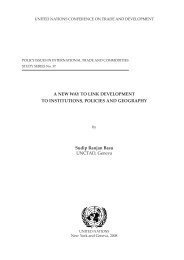



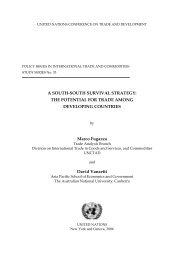
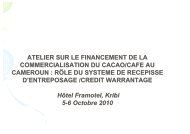
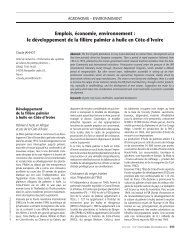
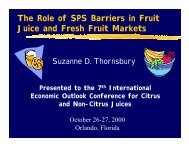

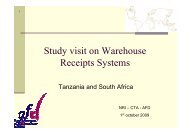
![Warehouse Receipt Systems: Legal Issues [PDF]](https://img.yumpu.com/43979338/1/190x134/warehouse-receipt-systems-legal-issues-pdf.jpg?quality=85)
